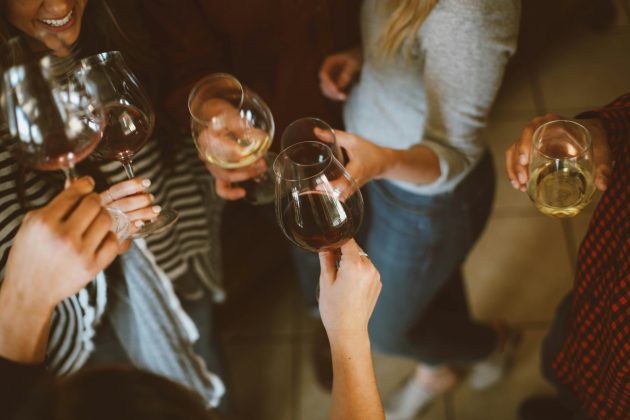There is an elephant in the room. The wine industry is at a standstill. Global consumption of alcohol is declining, and this is no secret. Younger generations drink less than those before them. But what does the wine industry do?
Understanding the reasons behind this decline – a thorny mix of health concerns, social media and public image, diversity and choice, and financial insecurity – and addressing the way drinking behaviors are changing could help this industry (an industry not known for its ability to impose… the law). rapidly changing) adapting to survive.
According to the European Parliamentary Research Service, wine consumption in the EU fell by 24% between 2010 and 2020.
Health-conscious consumers
Health and wellness trends push for moderation and abstinence. Strong messages about the negative health impact of consuming any amount of alcohol have increased debate. According to the World Health Organization, as of January 2023, “there is no safe amount of alcohol that does not affect health.”
Younger generations are more aware of what affects their health and well-being than generations before them at the same age. Generation Z in particular (born between 1997 and 2012) is exposed to a massive onslaught of information and data.
More than half of Generation Z and Millennials (those born between 1981 and 1996) in the U.S. consider drinking even moderately — one or two drinks a day — as unhealthy, says Erica Doisy, founder of the podcast and consultancy Business of Drinks (and GenXer). In the UK, about a third of Generation Z don't drink at all, according to marketing intelligence agency Mintel.
Concern for physical and mental health through moderation was the second most prevalent consumer sentiment around changing alcohol consumption behaviors globally, according to beverage market analysts IWSR BevTrac, based on data collected in the six months to April 2023.

Social media strains
Social media can perpetuate these feelings: “The depiction of success and what a good life looks like has changed a lot recently and has been sparked by social media,” says Jarlath Curran, director of wine logistics at Decanter and Millennials. “Everyone is beautiful, fit and healthy,” he adds, and for many, alcohol is incompatible with these goals.

Ben Franks, Chief Operating Officer of Canned Wine Co. Credit: www.benfranks.wine
Ben Franks, also a millennial and commercial director of Canned Wine Co, echoes this: “There's a lot of pressure on social media where everyone is expected to be healthy and super successful and always constantly achieving.” This makes us very conscious of our health.
Photographers' problems

Sophia Longhi, wine communicator and founder of Skin + Pulp. Credit: Skin + Pulp.
But it's not just the list of social media health influencers that are taking over Millennials and Gen Z. “It would be unwise to dismiss vanity, but also not wanting to embarrass “Yourself in public.”
It is important to acknowledge the differences between these two demographics. Millennials sit on the cusp between drinking for fun and bingeing, and worrying about health and image. Longhi feels the image is more prevalent among Generation Z, who are wiser to the repercussions of public embarrassment. A permanent record of them stumbling drunkenly through the gutter is not exactly the image they want to portray to future employers.
Longi also cites increased awareness of women's safety as a strong contender for putting off younger drinkers.
Cultural and social changes in drinking habits

Credit: Ellen Doggett
How we drink wine is changing. “People are going out less and being around each other's houses more,” Longhi says. The outstanding 2023/24 trade report from UK-based wine importer Liberty Wines reflects this. It shows that sales volume in restaurants and bars decreased by 19% between 2019 and the summer of 2023.
Granted, the first half of this period spanned coronavirus lockdowns, but the fact that this trend continues is notable. “There has been a significant shift towards drinking wine at home,” the report says.
“The way we socialize has changed,” agrees Curran. “Now we don't need to leave the house to feel interacted with people.” However, what this means is that the occasions when Gen Z and Millennials meet in person are special, so the desire to share good wine and good food is strong.
Franks believes connection is the important aspect: “It's about the physical act of sharing,” he says. “If anything, Millennials and Gen Z are over-sharing: they live their lives online, and if they have a social event in person, they put more effort into what they bring.”
Young drinkers see wine as an occasional treat. “It's very different from what we knew,” says Anne Burchett, a wine marketing and communications specialist, who believes that overindulgence and overindulgence were more socially acceptable (she is a baby boomer). “We need to accept that what becomes trendy and socially acceptable in one generation will automatically lose some of its luster in the next.”
Moreover, “younger generations in the United States are more ethnically diverse,” says Doisy. “Fewer and smaller numbers of the American population are coming from Eurocentric backgrounds or families who grew up drinking at the dinner table or at social gatherings.”
Drink less but drink better = prioritize fun
When and where we drink wine reflects changing social mores, but also the economic climate. Younger generations will spend more on less. “Although drinking rates are down, sales value is going up,” says Ellen Doggett, a former wine expert and millennial. “People want to drink better, and they are more careful about what they spend their money on.”
This bonus effect is not new, but has additionally been fueled by recent financial crises that have seen younger generations earning much less income than previous generations at the same stage of their lives. Their financial expectations for the future are not in the same realm. Traditional purchases such as homes and cars are no longer affordable, so spending on pleasure rises.

Ellen Doggett, former bartender and industry expert.
Although these two key demographics of Generation Z and Millennials may become wealthier as they age, they are unlikely to “age out” of wine, and “will never drink anywhere near as much as previous generations.” , he says. Miles Bell, CEO of the Wine and Spirit Trade Association and a member of Generation X. “I don’t think they will spend as much as baby boomers, who have enjoyed a long period of economic wealth.”
Spending is more tied to the ethics and values of younger consumers, says Longi, “and they tend to be quite loyal to the brands they identify with and that represent them.”
Purchasing habits

Credit: Canned Wine Company
For younger generations, it is clear where these values lie. Provenance, sustainability, authenticity and heritage are what drive their purchasing habits. This actually means that the quantity will shift down, as all these values come at a higher price.
This ultimately means a reduction in the consumption of cheap bulk wine. Something those in the wine industry will applaud.
“It's the most interchangeable and most forgotten category,” says Master Sommelier Stefan Neumann, an Austrian independent wine consultant who lives in London (and a millennial). This should be a concern for wine companies, as younger generations seek memorable experiences that they can share with others.
“The greatest hope is that in the short term we will see a reduction in over-industrialization in the wine industry, leading to more premium, better quality products,” Curran adds.
But is that simple? Longhi points out that this makes the wine, in some ways, more elitist and unapproachable. Constant financial pressure also changes how ambitious you are.
“I'm not sure the franchise can be guaranteed to survive,” Bell says. Recent data from the IWSR suggests that the franchising process is slowing down. “Consumers are cutting back on their alcohol spending as rising financial concerns and the cost of living crisis eat into their disposable income,” the report says.
In the United States, the astronomical rise of ready-to-drink beverages can be attributed in part to widespread hesitation toward the upfront cost of a full bottle of wine. “60% (of consumers surveyed) say price is very or extremely important in deciding which beverages to buy,” Doisy says. “Less than a third will spend more than $30 for a bottle of wine.” And 75% say they rarely or never buy wine for more than $50.
Ocean of choice

Too much choice is a bad thing when it comes to wine consumption. There is a wealth and variety of alcoholic and non-alcoholic drinks on the market, and younger generations are no stranger to experimentation. Moreover, these other categories connect with consumers very well.
“With no more low-drinks, there are now so many options, it's almost as if you were taking a risk with alcohol,” Franks says. “If anything, alcohol has become a bit too samey.” In the non-alcoholic category, you have kombucha, no/low beer, low spirits, all the different mixers and blends… there's a real element of choice and excitement in trying something new.'
But it's not just other drinks that are pushing wine off the radar of younger generations. Among Generation Z in the United States, “alcohol is being replaced by the use of cannabis,” Doisy says. “More than half the population in the United States lives in a state where cannabis is legal.”
As Dan Belmont, founder of Good Wine Good People and a Millennial, says: “With marijuana legalization, you have alternative ways to make a big splash.” This has also led to an increase in RTDs infused with CBD and THC, which have seen double-digit increases.

Erica Duesi, founder of the beverage company.
Lifestyle generations
Sentiment towards the future among industry professionals remains largely positive, albeit with continued concerns over increased UK tariffs. But the tide is turning against those stuck in their ways.
If the younger generation is to become involved in the wine industry, their needs and values must be taken into account, and this can foster innovation and positive change. From reducing packaging, to honest sustainability practices, being open to alternative formats, new and different flavours, and connecting through their favorite channels.
“We need to practice this constant creativity, constant renewal, constant change… We need to make sure the product is relevant to this younger generation,” Burchett says. “We have to be optimistic about the younger generation.
“I refuse to have this attitude that we're doomed and they're spending all their money on Starbucks. I think that's reductive and insulting and not very smart. Accept that they're different.”
Wine as part of an aspirational lifestyle, rather than overeating and heavy drinking, is more appealing to Generation Z. “I think it's an opportunity to move away from cheap bulk wine and reintroduce wine as a lifestyle choice,” says Longhi. “Wine can be part of a healthy, successful lifestyle.”
“A lot of it is about the winemaking so as not to make it more complicated than it needs to be,” Belmont says. We can show younger generations how wine can fit into their current lifestyles, rather than the industry forcing traditional pairings and attitudes on them that they can't relate to.


